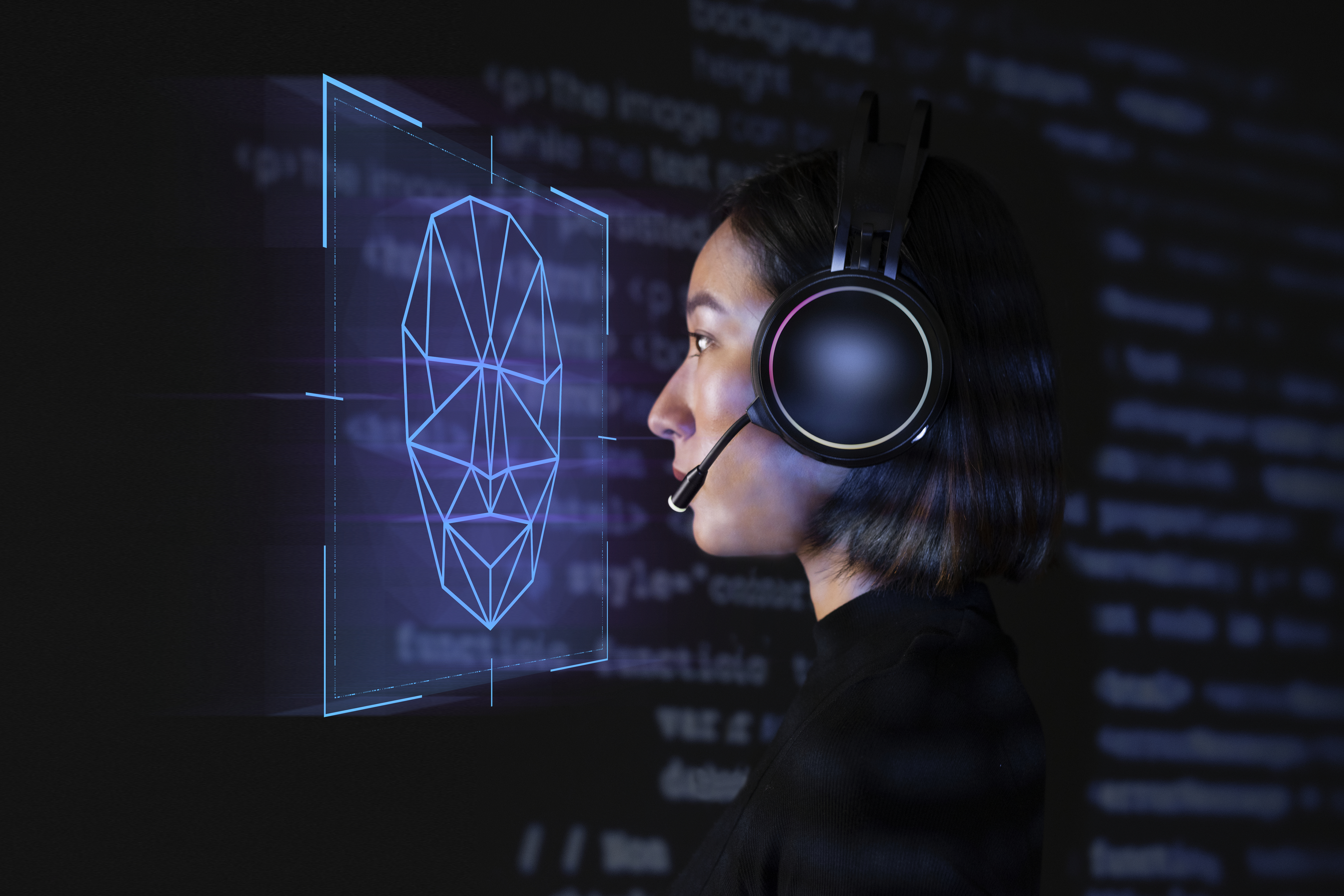Deep Q/A Engine
The Deep Q/A engine in Saltlux’s AI Suite is a system that finds and presents the best answers to the user’s questions from the accumulated knowledge by training it to learn. This is done by integrating knowledge base Q&A (KBQA), information retrieval based Q&A (IRQA), machine answering Q&A (MRCQA), counseling and dialogue history learning based Q&A (DLQA).
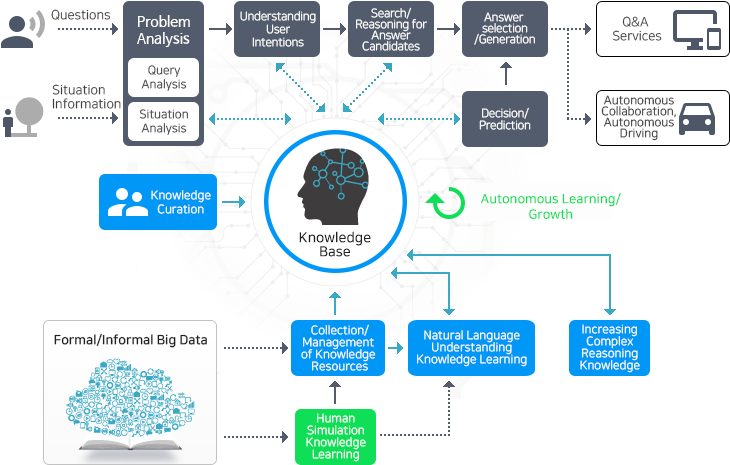
< Deep Q/A processing summary >
Main Features
- Massive and accurate knowledge graph-based Q&ADeep
Deep Q/A engines respond to inquiries using knowledge-level data rather than merely information-level data. It not only extracts and learns knowledge from the data automatically but also infers new knowledge hidden from the learned knowledge and uses it in the Q&A.
- Flexible Q&A using an ensemble technology
To respond to various user queries, each question and answer module is made into ensembles in which optimal answers are offered according to the query type. Furthermore, to reply to inquiries regarding real-time information like weather or stock prices, real-time information for Q&A can be accessed via external APIs.
- Quickly applicable in various domains
It offers a platform for information management such as dictionaries, knowledge, and indexes to handle Q&A by generating, learning, and inferring new knowledge based on the applied domain. The platform makes it easier to develop domain knowledge and implement Q&A in such fields.
Main features and specifications
Deep Q/A engines apply various QA methods to find the correct response based on the engine’s natural language understanding. With separate management tools, you can perform knowledge development, management, and service monitoring for deep query responses according to domain.
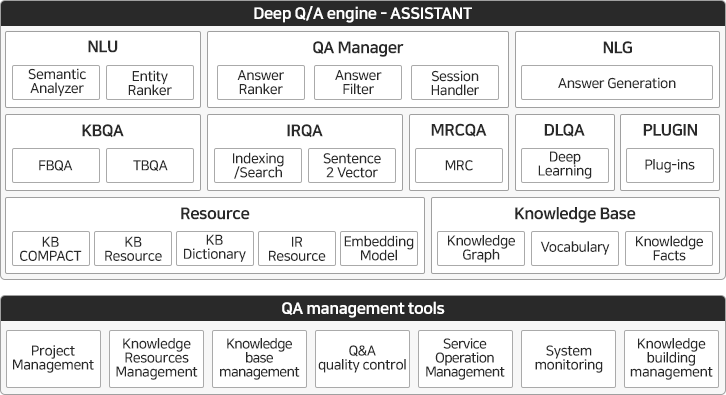
< Deep Q/A engine system structure >
- Ensemble Deep Q/A
The Deep Q/A engine provides an ensemble in which answers are explored using multiple methods based on high-precision natural language results. These include knowledge base, semantic search, machine learning, and deep learning.
① Knowledge-Based Question Answering, KBQA
It is a technique to identify a question’s core meaning and then access the knowledge graph repository for answers. Users can structure their information and create a matched knowledge base. Furthermore, they can quickly change and maintain knowledge while continuously improving the answer quality.
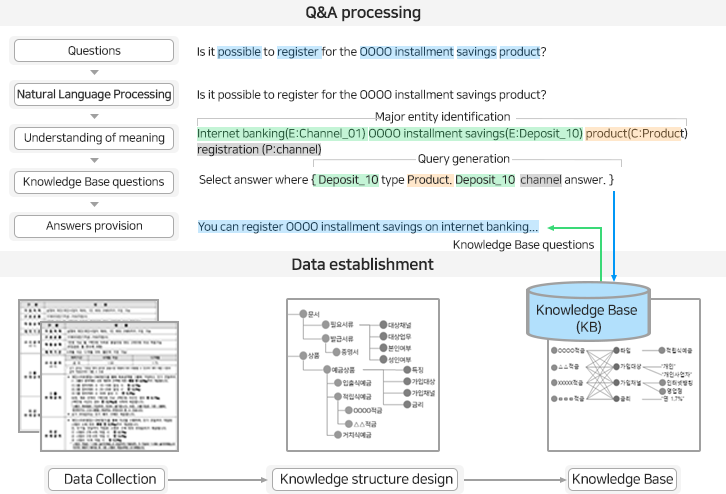
< Knowledge-based Q&A processing summary >
② Information Retrieval Question Answering, IRQA
IRQA of the deep QA engine is divided into the processing method based on the indexing technology and the processing method based on the embedding technology using the deep artificial neural network. Index-based IRQA is the most common question-and-answer approach that builds predicted question-answer data ahead of time, searching for and responding to questions similar to user’s questions.
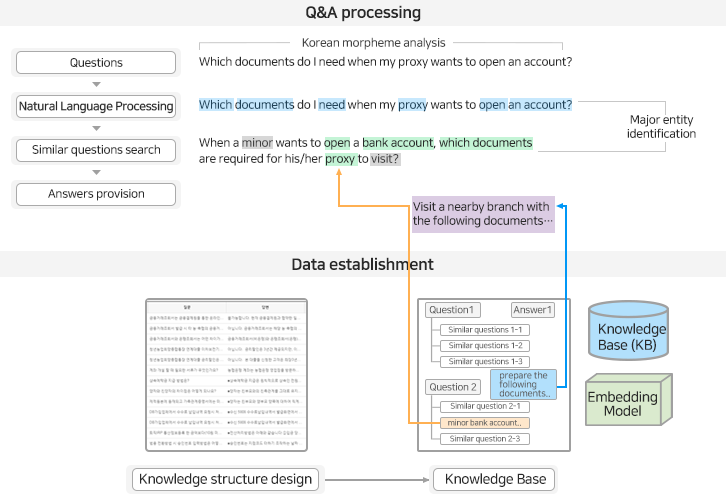
< Information search-based Q&A processing summary >
③ Machine Reading Comprehension Question Answering, MRCQA
It’s a method for robots to learn how to read documents, and find and present answers to questions without having to build knowledge. It answers queries by combining information retrieval methods that navigate the target document with machine-reading comprehension (MRC) approaches that find answers within the document.
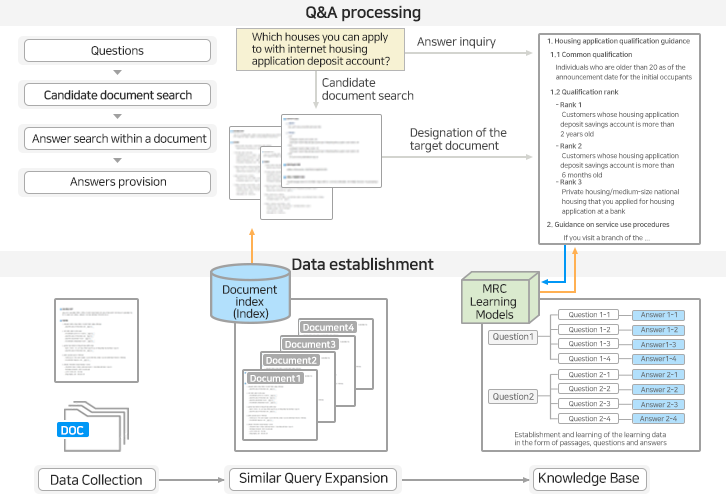
< Machine reading comprehension-based Q&A processing summary >
④ Dialog Learning-based Question Answering, DLQA
Based on deep learning models that have learned dialogue data such as actual counseling, dialogue history, and question and answer history, this method creates replies to queries automatically. You can build high-quality learning data in large quantities and improve quality through continuous learning and evaluation. The deep learning model’s answer can be delivered directly or utilized as a part of an ensemble Q&A process integrated with the KBQA, IRQA, and other services.
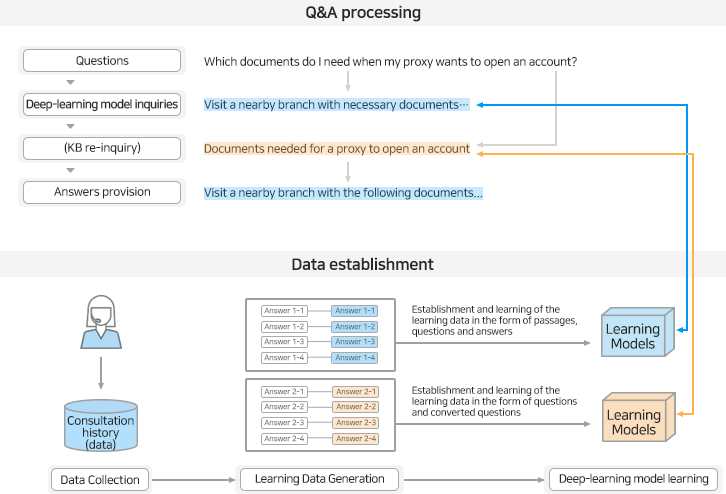
< Dialogue learning-based Q&A processing summary >
- Knowledge and language resource building management
The Deep Q/A engine provides an ensemble Deep Q/A in which answers are explored using a range of methods based on high-precision natural language findings, such as knowledge base, semantic search, machine learning, and deep learning.
① Knowledge building
You can create a task for knowledge building targets, designate workers (inspectors and curators), and assign it to them with the knowledge curation management tool. You can search the status of work by knowledge-building workers, and manage the building quality by verifying and reflecting the work results.
② Language resource (dictionary) management
It enables you to add dictionaries and update dictionary entries utilized by the deep query engine. The Natural Language Understanding Engine and the KBQA Engine largely employ dictionaries to identify the question’s meaning and match it with knowledge information.
③ Knowledge Base management
The engine provides data visualization along with detailed information on knowledge data, letting you explore the associated knowledge structures. You can manage the knowledge base’s data, and the knowledge graph schema and search for a class, property, and instance data independently. Query tools are also provided to run SPARQL queries directly.
- Q&A quality control
We provide quality management capabilities to monitor services and enhance quality using the Deep Q/A engine.
① Evaluation management
The Deep Q/A engine’s quality evaluation procedure involves creating an assessment set of questions and answers and evaluating the QA engine’s % correct on a regular basis. To facilitate continuous quality management, the Q&A tool includes assessment data management and scoring management features.
② Query test
It provides a query test feature that lets you enter specific questions to see what answers are actually It has a query test function that allows you to enter specific questions to see what answers the Deep Q/A engine returns. The query test results give log information that occurs at each stage of the Q&A procedures, enabling you to identify why the question was not answered and correct it.
- Q&A service management
It allows you to configure the Deep Q/A engine for Q&A service, system utilization, and a variety of other operation management functions.
① Project Management
Based on the target domain or service type, the Deep Q/A engine can build independent knowledge bases and Q&A systems. The Q&A management tool has a feature that allows you to set up and manage these systems as projects. The project management function enables the configuration and operation of the Deep Q/A engine and other linked engines.
② Q&A history management
The Deep Q/A engine provides a history management feature to store, manage and search the service history. You can continuously improve the quality of service by checking the service status and selecting and analyzing unanswered questions for future knowledge building or debugging.
③ System monitoring
It provides hardware-based monitoring of related systems, including a Deep Q/A engine.
④ Other operation management (emergency answer management)
When operating a service, an answer may need to be processed exceptionally before being evaluated by the Deep Q/A engine.
You can use emergency response management if you need to transform queries during the preprocessing stage or supply a predetermined answer.
It also includes activities such as user administration, notification management, and data management, all of which are essential for service functioning.
Main engine screen




